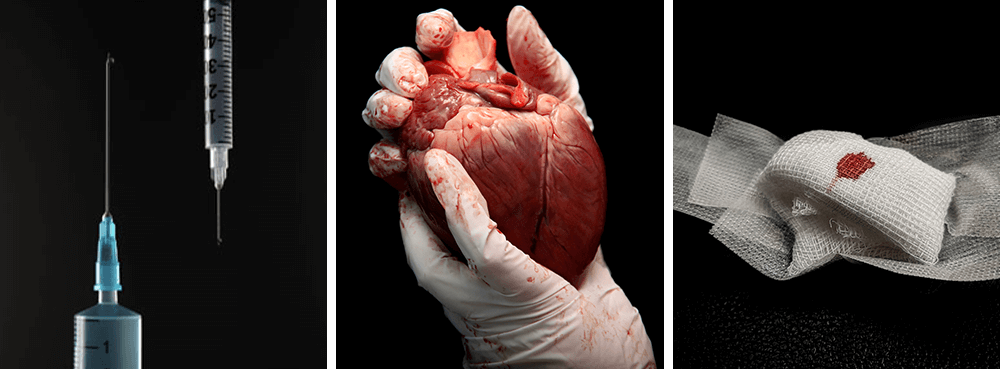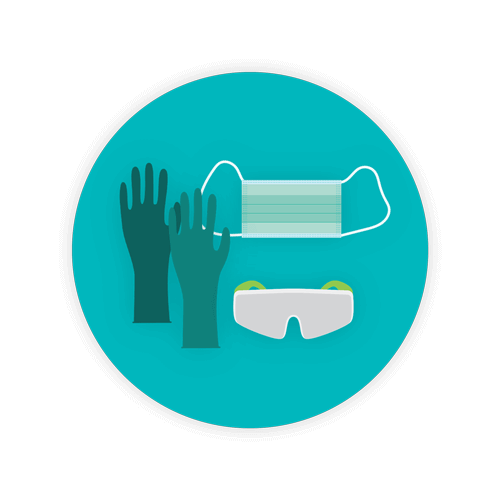What is Infectious Waste? – 10 Examples

If we can make this blog spread as though it’s infectious, we’ll be able to reduce infection risks in healthcare environments across the UK.
Infectious waste is a type of clinical waste that’s a critical concern in healthcare settings and beyond. This type of waste, which includes materials contaminated with potentially infectious substances, poses significant risks to human health and the environment.
Generated in hospitals, clinics, laboratories, and other settings, it requires careful handling and disposal. In the UK, strict regulations govern the management of infectious waste, with the National Health Service (NHS) alone producing an estimated 156,000 tonnes annually from secondary care.
This article explores the definition, examples, and proper management of infectious waste, focusing on UK regulations and best practices for its safe handling and disposal.
TOPICS WE WILL COVER:
2 / Key Characteristics of Infectious Waste
3 / Examples of Infectious Waste
4 / Identifying Infectious Waste
5 / Infectious Waste Bag Colour
7 / Infectious Waste Disposal Options
8 / Challenges in Infectious Waste Management
9 / Best Practices for Handling Infectious Waste
10 / Innovative Solutions for Infectious Waste Management
11 / Sharpsmart’s Innovative Approach to Infectious Waste Management
12 / Partner with Sharpsmart: Safe, Compliant Infectious Waste Disposal
What is Infectious Waste?
Infectious waste refers to contaminated waste materials that have the potential to transmit infections to humans or animals. It’s classified as any waste that may contain pathogens (disease-causing microorganisms) in sufficient concentration or quantity to cause disease in susceptible hosts.
Such waste typically originates from healthcare and laboratory settings, although it may also be generated through home-based healthcare. According to the UK government’s guidance on healthcare waste, infectious waste is classified as hazardous waste and requires special handling and disposal methods.
This type of clinical waste contains pathogens like bacteria, viruses, and other microorganisms – posing a hazard to anyone coming into contact with it and also has the potential to contaminate surfaces or materials it comes into contact with.
Key Characteristics of Infectious Waste:
- Contains viable microorganisms or their toxins
- Can cause or is capable of causing disease in humans or animals
- Requires special precautions in handling to prevent infection
Examples of Infectious Waste
Infectious waste can come from various sources within healthcare facilities and other settings. In the UK, the main types of infectious waste include:
 1. Sharps Waste:
1. Sharps Waste:
- Needles
- Hypodermic needles
- Medical equipment such as scalpels
- Broken glass and other sharp objects that have been in contact with infectious materials
- Biological wastes, including human tissues (or animal tissues)
- Body parts and organs removed during surgery or autopsy
- Surgical waste
- Diseased or removed specimens from medical procedures
 3. Infectious Clinical Waste:
3. Infectious Clinical Waste:
- Swabs, bandages, and dressings used in treating patients with infectious diseases
- Gloves, gowns, and other personal protective equipment (PPE) that have been in contact with infected materials or patients
4. Contaminated Blood and Body Fluids:
- Used blood bags
- Serum, plasma, and other human blood products (e.g. from discarded diagnostic samples)
- Other bodily fluids that might carry pathogens
5. Microbiological Waste:
- Laboratory wastes such as cultures and stocks
- Specimens from medical and pathological laboratories
6. Isolation Waste:
- Waste from patients with highly communicable diseases
 7. Pharmaceutical and Chemical Waste (with infectious contamination):
7. Pharmaceutical and Chemical Waste (with infectious contamination):
- Unused medicines contaminated with body fluids
- Chemical wastes contaminated with infectious agents
8. Cytotoxic and Cytostatic Medicines:
- When contaminated with infectious material
9. Animal Waste:
- Infected animal carcasses
- Animal body parts
- Contaminated bedding from veterinary sources or research facilities
10. Contaminated Equipment and Supplies:
- IV tubing
- Catheters
- Other disposable medical items that have been in contact with infectious agents
Each of these types of waste requires specific handling, containment, and disposal methods to prevent the spread of infection and protect public health. The UK government’s guidance on healthcare waste provides detailed information on the classification and management of these waste types.
Identifying Infectious Waste
 Proper identification and segregation of infectious waste are crucial for safe handling and disposal.
Proper identification and segregation of infectious waste are crucial for safe handling and disposal.
The HTM 07:01, the Department of Health’s guidance on the safe management of healthcare waste, tells us that infectious waste typically comes from hospital units dealing with patients (or their samples) and specific specialised areas.
Without testing waste it’s hard to be certain it’s contaminated with harmful agents, yet it’s not practical to test every possibly infectious item. However, there are ways to determine the likelihood of it being infectious. Consider if:
- It came from a patient with an infection, or from being in contact with someone carrying a contagious disease.
- It came from a patient displaying infectious symptoms who is yet to be fully diagnosed.
- It came from a patient with a history of a known infection – such as a blood-borne virus or Clostridioides difficile.
- A healthcare provider has confirmed it’s infectious.
- It’s a substance used in lab work containing infectious agents, or was in touch with them.
If the answer to any of those is “yes”, the waste may be infectious and you should treat it as such.
Free Resource: How to Identify Infectious Waste Poster
Infectious Waste Bag Colour
In the UK, specific colour codes are used for different types of clinical waste:
What Colour Bag for Infectious Waste?
When considering “What colour bag for infectious waste?” remember:
- Orange or yellow bags are the standard for infectious waste in the UK.
- The choice between orange and yellow depends on the specific treatment method required.
These two subsets of infectious waste are:
- Infectious waste for alternative treatment (orange bag): Refers to waste that has come into contact with infectious bodily fluids and isn’t medicinally or chemically contaminated. This also includes waste generated from a patient diagnosed with any type of communicable disease.
- Infectious waste for high-temperature incineration (yellow bag): Refers to waste classified as being highly infectious due to secondary contamination such as medicinal or chemical.
Infectious Waste Bins
There are many different types of bins in hospitals in a variety of shapes and sizes, but infectious waste bins should be:
- Clearly labelled with the biohazard symbol
- Rigid and leak-proof
- Able to be securely closed
- Easily cleaned and disinfected
Infectious Waste Disposal Options
Proper disposal of infectious waste is critical to prevent the spread of disease and protect public health. The Environmental Protection Act 1990 and the Hazardous Waste Regulations 2005 govern the management of infectious waste in the UK. Key steps in infectious waste disposal include:
- Segregation: Separating infectious waste from other types of healthcare/hospital waste at the point of generation.
- Packaging: Using appropriate containers and bags to prevent leakage and contamination. Always use the swan neck method to tie the bags when no more than three-quarters full.
- Labelling: Clearly marking containers with the type of waste and any relevant information about hazardous materials.
- Storage: Keeping waste in a secure, designated area until collection.
- Transportation: Using licensed waste carriers to transport waste to approved treatment facilities.
- Treatment: Employing technology, including medical waste incinerators and alternative treatments, to render the waste safe.
- Final disposal: Disposing of treated waste in accordance with environmental regulations.
Challenges in Infectious Waste Management
Managing infectious waste presents several challenges:
- Increasing volume: The growing healthcare sector and recent global health crises have led to increased volumes of infectious waste.
- Regulatory requirements: Keeping up with evolving regulations and ensuring consistent compliance across facilities.
- Environmental concerns: Balancing the need for safe disposal with environmental sustainability goals.
- Cost management: Implementing effective waste management systems while controlling costs.
- Staff safety: Protecting healthcare workers and waste handlers from potential exposure to infectious agents.
Best Practices for Handling Infectious Medical Waste
To minimise risks associated with infectious waste, healthcare facilities and other generators should follow these best practices:
1. Develop a comprehensive waste management plan: Outline procedures for identification, segregation, handling, and disposal of infectious waste.
2. Train staff regularly: Ensure all personnel are aware of the risks and proper procedures for handling infectious waste.
3. Use appropriate personal protective equipment (PPE): Gloves, gowns, and face protection should be worn when handling infectious waste.
4. Implement a colour-coding system: Use standardised colours for waste bags and containers to facilitate proper segregation.
5. Maintain proper documentation: Keep records of waste generation, treatment, and disposal for regulatory compliance.
6. Conduct regular audits: Assess waste management practices to identify areas for improvement and ensure compliance.
7. Stay updated on regulations: Keep abreast of changes in legislation and guidelines related to infectious waste management.
Innovative Solutions for Infectious Waste Management
To address the challenges associated with the management of waste with infectious properties, the healthcare industry is adopting innovative solutions:
1. On-site treatment technologies: Implementing technologies that can safely treat infectious waste at the point of generation, reducing transportation risks and costs.
2. Reusable containment systems: Adopting reusable containers for sharps and other infectious waste to reduce environmental impact and long-term costs.
3. Advanced tracking systems: Utilising RFID and other technologies to improve waste tracking and ensure compliance throughout the disposal process.
4. Automated segregation systems: Implementing smart waste bins that can automatically sort different types of waste, reducing human error in segregation.
5. Staff training and education programmes: Developing comprehensive training programmes to improve waste management practices and reduce risks.
 Sharpsmart’s Innovative Approach to Infectious Waste Management
Sharpsmart’s Innovative Approach to Infectious Waste Management
Sharpsmart UK offers comprehensive and compliant solutions for infectious waste disposal. With over 30 years of experience, Sharpsmart has revolutionised healthcare waste management through innovative technologies and a commitment to safety and sustainability. Sharpsmart’s infectious waste disposal services include:
- Customised waste segregation systems
- Reusable containment solutions that reduce environmental impact
- Secure collection and transportation of infectious waste
- Compliant treatment and disposal methods
- Detailed tracking and reporting for regulatory compliance
By partnering with Sharpsmart, healthcare facilities can protect human health, reduce the risk of injury for both staff and patients, and ensure their infectious waste is managed safely, efficiently, and in full compliance with UK regulations.
Partner With Sharpsmart: Safe, Compliant Infectious Waste Disposal
Effective management of infectious waste is crucial for protecting public health and the environment. By understanding what constitutes infectious waste, following proper disposal procedures, and adopting innovative solutions, healthcare facilities and other waste generators can significantly reduce risks associated with infectious waste.
Partnering with experienced providers like Sharpsmart UK ensures that infectious waste is handled safely, sustainably, and in compliance with all relevant regulations.
As the healthcare sector continues to grow and evolve, so too will the strategies for managing infectious waste, driving towards a safer and more sustainable future.
Contact us today to speak to one of our experts and take the first step towards improving the safety, compliance, and efficiency of your healthcare facility.
Let's Talk!
Your time is valuable, and we don’t want to play hard to get. You can either phone us directly on the details listed on our contact page, or feel free to fill out this short form and one of our team members will get back to you as quickly as possible.
